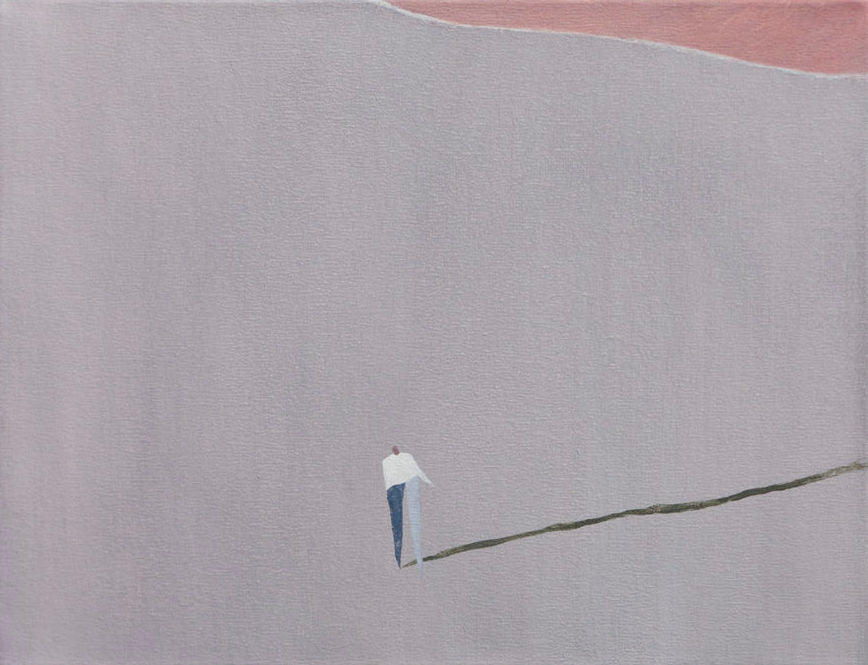In the Studio with Alan Ibell
Tell us about your current studio space. How does it affect the work you’re making?
I have an area of about 4 x 2m in a shared space in Kingsland. It’s an industrial space crudely converted into a kind of rabbit warren for artists. It’s the first shared studio I have worked from, but space in Auckland is at a premium so I have adapted! I like to prepare a large number of canvases at the beginning of the year so there are stacks of canvases leaning against the walls. I usually work on about six or seven paintings at a time so I can keep a level of consistency within the series. The scale of my work can vary and my space allows me to hang one or two large works or a number of small works on the walls to consider as I work at the easel. I also frame the work myself so at various times I wheel away the easels and wheel out the tools to transform the studio into a workshop for framing and stretching canvases.
What’s the first thing you tend to do when you enter your studio for the day/do you have a creative exercise/process that helps you begin your work?
I like to leave the studio tidy when I leave after a day’s work so that when I arrive in the morning I can approach with a clear perspective. I generally put on a pot of coffee and sit with yesterday’s work for a moment. Because people are coming and going in the shared space I wear headphones to avoid distraction – during the mentally intensive planning stages of a work, I generally listen to music, but once I’m putting paint on canvas I’ll listen to podcasts or National radio.
Can you identify a pivotal place or experience that you feel has had a particular influence over the current direction of your work?
In 2015 I had an artist’s residency in Assisi, Italy. My main motivation to go to Italy was to see the works of the Early Renaissance master Giotto, an artist who has long inspired me. While in Assisi I had the chance to spend quite some time with Giotto’s Legend of St Francis fresco cycle in the Basilica di San Francesco. I knew the works from reproductions but seeing them in the flesh was awe-inspiring. Only by seeing the architectural scale of the works in the context of the church did I understand that their function was far more than simply objects to admire; they are part of the materiality of the town and have a spiritual significance that is woven into the community, its history and sense of place. This experience helped me understand the importance of the environment in which a painting is exhibited. Since then I have taken a more considered approach to the ways in which the architecture of a gallery can inform the works and vice versa.
When you have a day away from the studio where do you like to go?
I will make a point of going to any exhibitions around Auckland that look interesting. The beauty of living in the big smoke is that there are usually one or two inspiring exhibitions happening at any given time and it’s nice to keep up with what other artists are doing. I usually find time in the week to go op shopping – I have a collection of ‘naïve art’ that I’ve sourced from op shops and I’m always looking to add to…
If you could collaborate with any artist within history who would it be and what project would you work on together?
Piero Della Francesca. I imagine travelling back in time and working as one of his assistants while he painted the Legend Of The True Cross fresco cycle in Arezzo, Italy. I’m fascinated by the way his use of mathematics and geometry underscores the spirituality of his compositions, and my colour palette has been strongly influenced by his.
Or I would be drinking-buddies with Van Gogh.
What drives you to devote your life and career to making art?
I have always been drawn to painting and for some reason continuing to paint has overridden any other instinct. For me, painting provides a method of processing the absurdity of human experience – my hope is that my works can stir a similar meditative experience within those who view them.
What’s the best arts-related advice you’ve been given?
An established artist friend once told me that you don’t need to reinvent your practice after each exhibition – you can build on existing ideas, rather than forcing yourself to constantly develop brand new ones. I have also taken some practical advice to heart, namely that a professional artist should dedicate approximately 60% of their working time to their studio and the other 40% to professional practice – research, writing artist statements, applying for residencies etc. So often as an artist it’s hard to gauge how the trajectory of your career is going but this has offered me some form of practical framework for structuring the day-to-day.
What projects are you currently working towards?
I have just finished working on a show for the Pah Homestead in which I made works in response to the Trust’s collection. I am currently working towards my show for Parlour Projects titled An Angel, Then! This series interrogates the search for self-fulfilment and the expectations that we place on the external world to provide it. Later in the year I begin a two-month residency at Karekare House just out of Auckland. I’m excited about the excuse to hermit away for a dedicated period to work and soak up the wild surrounds.



